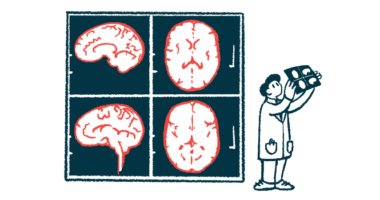AAN 2023: P2B001 controls symptoms with less sleepiness
Fewer Parkinson's patients on Pharma Two B therapy had orthostatic hypotension

The investigational combination therapy P2B001 was similar to Mirapex (pramipexole) at controlling symptoms of Parkinson’s disease in a clinical trial. But patients treated with P2B001 were less likely to experience sleepiness and fewer had orthostatic hypotension (a sudden drop in blood pressure on standing) as side effects.
Lawrence Elmer, MD, PhD from the University of Toledo, presented the trial’s findings at the American Academy of Neurology (AAN) annual meeting, held this week virtually and in Boston, in a talk titled, “P2B001 (low dose combination of extended-release pramipexole and rasagiline) versus titrated extended-release pramipexole in the management of early Parkinson’s disease: Exploratory findings from a randomized, controlled trial.”
The study was funded by P2B001’s developer Pharma Two B. The company is planning to apply for approval of P2B001 in the U.S. this year, based on the data.
“We believe the data presented at AAN this year continue to support the development of P2B001 as a potential first-line therapy for people with” Parkinson’s, Dan Teleman, president of Pharma Two B, said in a company press release.
Parkinson’s is marked by low levels of the brain signaling molecule dopamine. P2B001 contains a fixed-dose combination of two medications in extended release form — pramipexole, which mimics dopamine activity in the brain, and rasagiline, which increases dopamine levels by blocking a protein that normally helps recycle it. Extended release means the medicine is formulated so it’s released slowly.
Both medications are approved individually to manage Parkinson’s symptoms. Pramipexole is marketed by Boehringer Ingelheim as Mirapex; Teva sells rasagiline under the brand name Azilect.
In animal studies by Pharma Two B, the combination of the two medicines showed synergistic effects. “The sum of the parts is much greater than the individual component themselves,” Elmer said, noting P2B001 contains both therapies at doses lower than what’s used in the single-medication treatments.
Testing P2B001 against separate medications, extended release Mirapex
The company ran a Phase 3 clinical trial (NCT033295508) that enrolled more than 500 people with recently diagnosed Parkinson’s who hadn’t yet begun treatment. They were divided into four groups and treated for 12 weeks, about three months.
One group received P2B001 and two other groups got pramipexole or rasagiline separately at the same dosage in the combination therapy. The fourth group was treated with the approved extended release formulation of Mirapex. In this group, the dosage was adjusted based on patients’ response and tolerability.
Top-line results, reported in late 2021, showed P2B001 was more effective than either of its individual components at controlling symptoms.
At AAN, Elmer presented a comparison between the 157 participants treated with P2B001 and the 77 given Mirapex.
Demographics and clinical characteristics in both groups were similar at the study’s start. The average age was in the early 60s, about two-thirds of patients were male, and more than 95% were white. The average time between getting diagnosed with Parkinson’s and entering the trial was about half a year.
At the start, the average total score on the Unified Parkinson’s Disease Rating Scale (UPDRS) — a global measure of symptom severity in Parkinson’s — was about 30 points in both groups. After 12 weeks, the average score decreased by about 8 points in both groups, reflecting less severe symptoms. While there was some variability in response to both medications, about three-quarters of the patients in both groups improved by more than 4 points on the motor UPDRS score.
All in all, both P2B001 and Mirapex showed “comparable efficacy,” Elmer said, adding, for clinicians, the take-home message is “if you see a patient newly diagnosed with Parkinson’s disease, this [P2B001] may be an option if indeed it is approved by the FDA.”
Comparing effects on sleepiness
Safety data showed that markedly fewer patients on P2B001 than Mirapex had orthostatic hypotension (2.7% vs. 12.2%) or sleepiness (14.7% vs. 31.1%). Over the 12-week study, dopamine-related side effects were significantly less common with P2B001 (44.7% vs. 66.2%), statistical analyses showed.
At a separate poster at AAN, researchers presented detailed analyses of the effect of P2B001 on sleepiness, a common side effect of dopamine agonists like Mirapex in a poster titled, “P2B001 significantly reduced risk of daytime sleepiness: results from a randomized controlled phase 3 trial with active pramipexole arm in early Parkinson’s disease (PD).”
Daytime sleepiness was assessed with a standard test called the Epworth Sleepiness Scale (ESS). At the start of the study, the average ESS score was about 5.5 points in both groups. After 12 weeks, the average score was about the same with P2B001, but increased to more than 8 points with Mirapex, reflecting more sleepiness.
Most patients (more than 85% in both groups) had ESS scores of 10 or lower at the start of the study, which generally reflects daytime sleepiness that doesn’t cause significant daily problems.
Among those starting with low scores, ESS scores increased past 10 in fewer than one in 10 (8.5%) of the patients given P2B001 after 12 weeks of treatment. More than one in three (35.7%) patients on Mirapex experienced new significant sleepiness.
“Patients treated with P2B001 developed significantly less new-onset [excessive daytime sleepiness] and fewer sleepiness-related [side effects],” the researchers said.
“The results of this Phase 3 trial represent positive news for newly diagnosed [Parkinson’s] patients, as there has been a clear unmet need for an initial, once-daily treatment that has demonstrable efficacy and safety, requires no titration, and has a lower incidence of excessive daytime sedation compared to” Mirapex, Elmer said.
Note: The Parkinson’s News Today team is providing coverage of the American Academy of Neurology (AAN) 2023 Annual Meeting April 22-27. Go here to see the latest stories from the conference.







